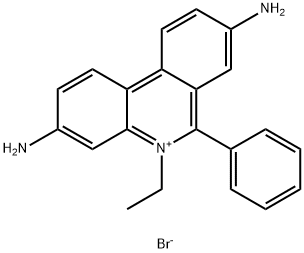A7066458
Ethidiumbromide(EB) , 10mMinDMSO , 1239-45-8
Synonym(s):
3,8-Diamino-5-ethyl-6-phenylphenanthridinium bromide;EtBr;Homidium bromide
CAS NO.:1239-45-8
Empirical Formula: C21H20BrN3
Molecular Weight: 394.31
MDL number: MFCD00011724
EINECS: 214-984-6
| Pack Size | Price | Stock | Quantity |
| 1ml | RMB159.20 | In Stock |
|
| others | Enquire |
Update time: 2022-07-08
PRODUCT Properties
| Melting point: | 260-262 °C (dec.)(lit.) |
| Density | 1.3739 (rough estimate) |
| bulk density | 340kg/m3 |
| refractive index | 1.6700 (estimate) |
| Flash point: | >100°C |
| storage temp. | 2-8°C |
| solubility | H2O: 10 mg/mL, opaque, strongly red |
| form | powder |
| color | Red to dark purple |
| Odor | Odorless solid |
| PH | 4.4 (20°C, 10g/L in H2O) |
| Water Solubility | 40 g/L (25 ºC) |
| λmax | 518 nm, 210 nm, 285 nm, 316 nm,
343 nm, 480 nm, 525 nm |
| Merck | 14,4731 |
| BRN | 3642536 |
| Stability: | Stable. Incompatible with strong oxidizing agents. |
| Biological Applications | Nucleic acid hybridization; detecting nucleic acids,cells,cancer cells,human cytomegalovirus,hydrogenase A (hydA) of Clostridia,influenza A virus,oligonucleotides,viable Plesiomonas shigelloides; apoptosis assay; nucleic acid quantification |
| Major Application | Electroluminescent displays;photoresists |
| CAS DataBase Reference | 1239-45-8(CAS DataBase Reference) |
| EPA Substance Registry System | Phenanthridinium, 3,8-diamino-5-ethyl-6-phenyl-, bromide (1239-45-8) |
Description and Uses
Ethidium bromide (EtBr) is the most commonly used nucleic acid stain for PAGE or agarose gel electrophoresis. The fluorescence of EtBr increases 21-fold upon binding to double-stranded RNA and 25-fold on binding double-stranded DNA so that destaining the background is not necessary with a low stain concentration (10 μg/ml). Ethidium bromide has been used in a number of fluorimetric assays for nucleic acids. It has been shown to bind to single-stranded DNA (although not as strongly) and triple-stranded DNA. Because of its ability to bind to DNA, EtBr is an inhibitor of DNA polymerase. Antiprotozoal (Trypanosoma).
Safety
| Symbol(GHS) |   GHS06,GHS08 |
| Signal word | Danger |
| Hazard statements | H331-H341 |
| Precautionary statements | P202-P261-P271-P280-P304+P340+P311-P308+P313 |
| Hazard Codes | T,T+ |
| Risk Statements | 23-68-36/37/38-26-21/22-22 |
| Safety Statements | 36/37-45-36/37/39-28A-26-22-28-63 |
| RIDADR | UN 2811 6.1/PG 1 |
| WGK Germany | 3 |
| RTECS | SF7950000 |
| F | 8-9 |
| HazardClass | 6.1 |
| PackingGroup | I |
| HS Code | 29339990 |
| Hazardous Substances Data | 1239-45-8(Hazardous Substances Data) |
| Toxicity | Intercalating dye widely used to stain DNA in gels and gradients. The DNA can be visualized readily by irradiation with ultraviolet light, as little as 0.5 μg of DNA being detectable by such methods. Ethidium bromide is also added to cesium chloride density gradients, since as an intercalating molecule it binds more readily to linear DNA than to closed collinear circles of DNA (such as plasmids). Binding of ethidium bromide reduces the density of DNA, thus covalent circles of DNA have higher densities at saturating concentrations of ethidium bromide, permitting the separation of plasmid DNA. Ethidium bromide is a putative carcinogen. |



